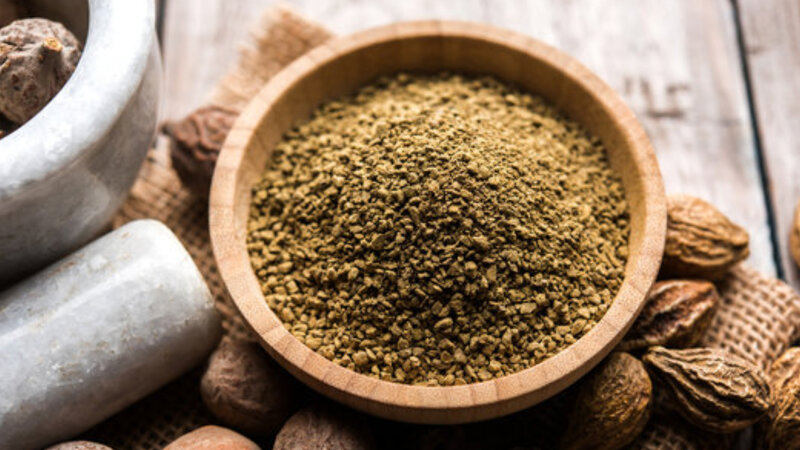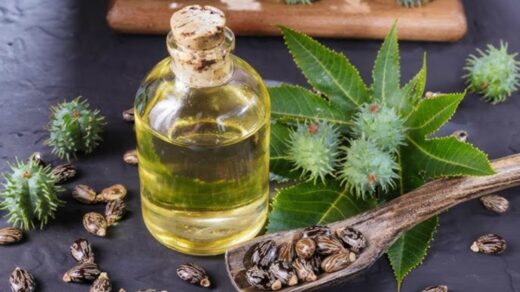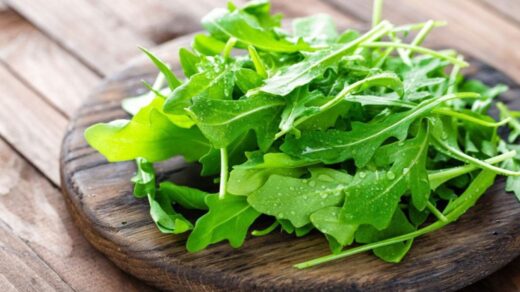Haritaki Churna: Unlocking the Power of Nature’s Healing Herb
Haritaki churna, derived from the dried fruit of the Terminalia chebula tree, is a popular herbal formulation in Ayurvedic medicine. With a history dating back thousands of years, Ayurveda is a traditional system of medicine originating from India that emphasizes natural remedies and holistic well-being.
Haritaki churna, often referred to as the “king of herbs” in Ayurveda, has gained recognition for its potential health benefits and versatile uses. Haritaki churna is prepared by grinding the dried fruit of the Terminalia chebula tree into a fine powder.
The fruit, commonly known as haritaki or harad, is a rich source of bioactive compounds, including tannins, flavonoids, and antioxidants. These compounds are believed to contribute to the various therapeutic properties associated with haritaki churna.
One of the primary uses of haritaki churna is for digestive health. In Ayurvedic medicine, it is considered a potent digestive tonic. The churna is believed to stimulate the digestive system, enhance metabolism, and promote healthy bowel movements.
It is often used to alleviate constipation, indigestion, and flatulence. Additionally, haritaki churna is thought to balance the doshas (energies) in the body, particularly Vata and Pitta doshas, which are associated with digestive imbalances.
Scientific classification
- Kingdom: Plantae
- Species: T. chebula
- Division: Magnoliophyta
- Family: Combretaceae
- Order: Myrtales
- Genus: Terminalia
- Class: Magnoliopsida
Vernacular Names (Common name in India)
- Hindi: Harara, Harad.
- English: Chebulik myrobalan.
- Santhal: Rola, Hadra.
- Bengali: Haritaki.
- Sindhi: Har.
- Gujarati: Hardo.
- Persian: Halilah, Halilahe-sard, Halilahe-siyah.
- Arabic : Halilaj,Halilaje-asfar, Haliaje-asvad.
- Kannada: Harra, Karakkayi, Aalekayi.
- Konkani: Ordo.
- Malayalam: Katukka.
- North-Western Part: Har, Haraira, Harara.
- Kashmir: Halela.
- Marathi: Hirda, Hirda-phula, Bala hirade.
- Punjabi: Har, Halela, Hurh, Harrar.
- Oriya: Haridra, Horitoli, Jonghihorida, Karedha, Harira.
- Tamil: Katukkay.
- Assam: Silikha, Hilikha.
- Tel: Karakkaya.
- Kashmir: Karka, Harro, Hir.
- Urdu: Haejarad.
Description Of Haritaki plant
Plant: Haritaki (T. Chebula), Inknut is found in medium-sized plants to big with thick branches, it is a deciduous tree that can grow up to the height of 30 m and grow up to 1-1.5 m in diameter. The trees may grow at high altitude places, about a height of about 2000 m from the sea level, and in areas where annual rainfall is about 100-150 cm, temperature about 0-17° C.
Leaves: The leaves are oval-like shapes with10-30 cm long with an acute tip with a cordate base. The leaves consist of 6-8 pairs of veins.
Flower: The flowers are short-stalked, dull white to yellow, monoecious, with a strong unpleasant odor, and are found in simple terminal spikes or short panicles.
Fruits: The fruits are 3-6 cm long with 1.3-1.5 cm width, appearance yellowish-green ovoid drupes containing one oval seed. Haritaki (T. chebula) is capable of growing in variable conditions, a variety of soils, clayey as well as shady.
Native: (T. chebula) Haritaki though it is native to Asia, but also found in Nepal, Myanmar, Sri Lanka, Bangladesh, Egypt, Turkey, and Iran it is also found in Pakistan and Yunnan, Guangdong, Tibet, and Guangxi province of China. In India, it grows in deciduous forests of Uttar Pradesh, Himachal Pradesh, Kerala, Karnataka, Tamil Nadu, Andhra Pradesh, and West Bengal.
Varieties Of Haritaki Fruits
There are different types of fruits, T. chebula (haritaki) they are classified into seven types, among which Vijaya is considered to be the best.
- Vijaya: In Vindhya (oval in shape)
- Amruta: Champaranya ( bulky)
- Abhaya: Champadesha (fruit has five lines on it) (eye diseases)
- Chetaki: Found in the Himalayas (having three lines on it)
- Pootana: Sindh (small and less bulky)
- Rohini: found everywhere (round in shape)
- Jeevanti: Saurashtra (yellow in color)
The 5 Rasas Of Haritaki Churna
- Madhur (sweet) The taste of fruit pulp
- Amla (sour) The taste of a bulky portion of the fruit
- Tikta (bitter) The taste of the seed
- Katu (shell) The taste of covering the fruit
- Kashaya (astringent) The taste of a hard portion of the seed.
Thus, haritaki is pancharasatmak which Ayurvedic texts prioritize the daily use of haritaki for regularizing all the normal functions of the body.
Seasonal (Ritu) Doses Of Haritaki Churna
Haritaki or the so-called Inknut is important which is known as Rasayana (medicine with rejuvenation, and anti-aging properties). The consumption of Haritaki churna is recommended with different ingredients in different seasons this is for this reason called Ritu (seasons) Haritaki.
- (July-August) Varsha Ritu: In monsoon, Haritaki churna is taken along with Saindhava (Rock Salt)
- (September-October) Sharat Ritu: In the Autumn season, it is given with Sharkara ( sugar)
- (November- December) Hemanta Ritu: In early winter, it is given together with shunti (ginger)
- (January-February) Shishira Ritu: In winter, it is given with Pippali (Piper longum) or (Long pepper)
- (March-April) Vasanta Ritu: In Spring, it is given along with Madhu (honey)
- (May-June) Greeshma Ritu: in the summer season, it is given along with Guda (jaggery)
Action (Karma) Of Haritaki Churna According To Ayurveda
- Deepaniya: Increases appetite
- Rasayana: Rejuvenative
- Brahmana: Nourishing
- Pachana: Digestive
- Yogavahi: Catalyst amplifies the action of other herbs
- Grahn: Absorbs fluids from the intestines
- Lekhaniya: Scrapes accumulation from the tissues and channels
- Anuloma: Corrects the flow of Vata downwards
- Chakshushya: Improves the eyesight
- Rachana: Purgative
- Stanyashodhana: Purifies breast milk
- Vibandha Hara: Alleviates constipation
- Medhya: Improves intellect
- Ayuvardhak: Increases longevity
- Arshoghna: Anti-haemorrhoidal
Ayurvedic Formulations Made From Haritaki Churna
- Abhayarishta
- Agastya Haritaki Rasayana
- Chitraka Haritaki
- Danti Haritaki
- Dashamula Haritaki
- Brahma Rasayana
- Triphala Churna
- Vyaghri Haritaki
- Triphala Kvatha Churna
- Pathyadi Kvatha Churna
- Phalatrikadi Kvatha Churna
- Abhaya Vati
- TriphalaMandura
- Shothari Mandura
- Amavatari Rasa
- Jalodarari Rasa
- Nityananda Rasa
How Can I Get Rid Of Dark Circles With Haritaki Churna?
Haritaki churna has potent Chakushya properties that are very useful in dealing with a large number of eye problems like watery eyes, dry eyes, stye infections, inflamed eyes, etc. It also has antioxidant properties that help to reduce pigmentation and oxidative damage. It is extremely beneficial for treating dark circles.
How to use: Take a spoonful of Haritaki churna, almond oil 2 drops, and ½ spoonful of fresh gel aloe vera plant.
- Mix this ingredient properly with rose water and apply this paste around the eyes. Let it be kept for around 15-20 minutes and wash it with cool water.
- Repeat this pack thrice a week.
How To Use Haritaki Churna For Different Ailments?
1. For Cough and cold
Haritaki churna is traditionally believed to possess expectorant properties, which may help in relieving cough symptoms by loosening mucus and facilitating its expulsion. Additionally, it is thought to have antimicrobial properties that could potentially aid in combating the underlying infections associated with colds.
How to use: Take powder of Haritaki with honey and consume.
- Take 2-3 pinches of powder with honey for small children.
- Take 1/2 teaspoon of powder with honey For adults
2. Increase libido Sex
In Ayurveda traditional practices, haritaki is often regarded as a rejuvenating herb that promotes overall vitality and well-being. Some proponents suggest that its adaptogenic and antioxidant properties may indirectly contribute to an improvement in sexual health.
How to use: Consume the jam made with Haritaki churn and jaggery.
- Take 1-2 gm of Haritaki churna with water every day for one month and you will find the change. It is also beneficial in problems like nightfall and increases strength.
3. Heartburn and constipation
Heartburn is a condition characterized by a burning sensation in the chest or throat, typically caused by acid reflux. Haritaki is believed to have properties that may help alleviate heartburn symptoms, such as its potential to reduce gastric acidity and improve digestion.
How to use: Take powder of Haritaki in hot water, mix well, and consume.
- Take 1/2 teaspoon of powder in a glass of warm water and drink.
4. Sore throat: It is an amazing herb that can be beneficial in solving problems related to the throat.
How to use: Gargle the liquid of Haritaki churna for sore throat.
- Take a glass of water in a vessel, mix one teaspoon of Haritaki churna in it, and boil. Gargle the mixture of the water temperature that is bearable to you. You can even do this regularly to maintain healthy gums and teeth.
5. Hemorrhoids: Haritaki is very good for treating problems such as hemorrhoids
How to use: Consume the jam made with Haritaki churna and jaggery.
- Take Haritaki churna and mix it with jaggery with a ratio (of 1:1). Consume the jam before eating food this will reduce itching, pain, and the size of
- Take one teaspoon of Haritaki churna and mix it with one glass of buttermilk it will also benefit in dealing with piles.


























Halo, cuma ingin mengatakan aku menikmati menulis ini.
Itu praktis. terus posting!
In Sanskrit, Tri means three, while phala means fruits. Thus, Triphala is a concoction made from 3 fruits. This herbal concoction has been used in Ayurveda for thousands of years.
Trifala is a potent Rasayan which ensures bio cleansing and detoxification of the body, ensuring a blissful long life. It is a great tonic, rejuvenator, rich source of antioxidant blood purifier, and bowel regulator.